Monday, January 31, 2005
More on Mr. Johnson
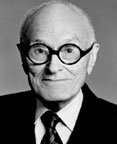 His life and his work evoked strong feelings. He was a complicated character. Drawn to fascism in his early adulthood, he was later publicly apologetic. Was designing a synagogue for free atonement enough, and of the proper sort? Closeted until late in life, after coming out he coyly referred to his succession of partners as "the four Mrs. Johnsons." The last, David Whitney, was his companion for 45 years, considerably longer than most marriages endure. How does one take the full measure of a man's life? And his work... what to say about the built artifacts of a 50-year architectural career? Some were great, some were laughable, some were even - perhaps his worst fear - dull. Much is being written at his passing about the man and his architecture; here are a few interesting assessments.
His life and his work evoked strong feelings. He was a complicated character. Drawn to fascism in his early adulthood, he was later publicly apologetic. Was designing a synagogue for free atonement enough, and of the proper sort? Closeted until late in life, after coming out he coyly referred to his succession of partners as "the four Mrs. Johnsons." The last, David Whitney, was his companion for 45 years, considerably longer than most marriages endure. How does one take the full measure of a man's life? And his work... what to say about the built artifacts of a 50-year architectural career? Some were great, some were laughable, some were even - perhaps his worst fear - dull. Much is being written at his passing about the man and his architecture; here are a few interesting assessments.
Form Follows Fascism
By Mark Stevens, January 31, 2005 in the New York Times
The death last week of Philip Johnson, the nonagenarian enfant terrible, brought 20th-century architecture to a symbolic close. Even Mr. Johnson's friends sometimes doubted that he was an architect of the first rank, but friend and foe alike agreed that he was an emblematic figure of his time.
But emblematic of what? In death, his role in American culture will come into sharper focus, and it's a darker picture than many have thought. Read More
Lived in Glass House, Threw Stones:
How Philip Johnson lost his way
By Witold Rybczynski, Friday, Jan. 28, 2005 on Slate.com
Many of Philip Johnson's obituaries describe him as the dean of American architects. He was undoubtedly a force in American architecture and exercised a major influence on the profession, but "dean" implies benevolent leadership. Johnson's influence was not altogether benign.
At the beginning of his involvement with architecture, he was simply a spokesman and promoter of the new Modern (at that point chiefly European) architecture. In 1932, with Henry-Russell Hitchcock, he organized an influential exhibit at the Museum of Modern Art and published The International Style. He put his money where his mouth was and built himself a house—the so-called Glass House—that became one of the most famous symbols of the new style. In the mid-1950s, he was at the side of Ludwig Mies Van der Rohe, helping him to design what many consider the greatest building of the postwar period, the Seagram Building.
"I don't want to be interesting, I want to be good," Mies is supposed to have said. But the mercurial Johnson, who seemed to get easily bored, definitely preferred interesting. Read More
A Tastemaker Propelled by Curiosity
By Nicolai Ouroussof, January 27, 2005 in the New York Times
At the height of his power, Philip Johnson's tentacles seemed to reach into every corner of his profession. As the founding director of the Museum of Modern Art's department of architecture and design, he almost single-handedly introduced American audiences to European Modernist buildings; he was a tireless promoter of emerging architectural talents, from Mies van der Rohe to Frank Gehry. And although he often played down his creative talent, he produced a number of 20th-century landmarks in his long, eclectic career, among them the 1949 Glass House, rightly considered a masterpiece of American design.
Yet his greatest talent of all may have been his unquenchable curiosity, which prevented him, and by extension, his audience, from becoming mired in any specific architectural style or movement. Read More
Friday, January 28, 2005
Ars longa, vita brevis
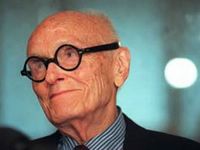 Philip Johnson was one of the first architects whose work I remember. I grew up in Houston in the 1960's and 1970's, in the period during which Philip Johnson was changing that city's skyline for the better. I might not have paid attention to Johnson's work at that time, however, had it not been for my architect father, who was always saying, "Look! Look at that."
Philip Johnson was one of the first architects whose work I remember. I grew up in Houston in the 1960's and 1970's, in the period during which Philip Johnson was changing that city's skyline for the better. I might not have paid attention to Johnson's work at that time, however, had it not been for my architect father, who was always saying, "Look! Look at that."
According to the Houston Chronicle, Johnson said in a 1991 interview, "Houston is undoubtedly my showcase city. I saved all my best buildings for Houston." Here are a few of those buildings:
University of St. Thomas Campus and Chapel of St. Basil
The campus of the University of St. Thomas, a small Houston college, was Johnson's second Houston commission. (His first was the house he designed for Dominique and John de Menil. Finished in 1951, it was the first flat-roofed modern house in its wealthy River Oaks neighborhood.) Built in the mid-1950's, the campus is a modernist take on Thomas Jefferson's plan for the University of Virginia, with brick and glass academic buildings connected by black steel-framed covered walkways on either side of an open lawn. Whereas the library was the focal point of Jefferson's design, at St. Thomas the focus is the Chapel of St. Basil. Part of the original campus plan, the chapel was not built until 1997... by which time Johnson's design sensibilities had changed dramatically. The chapel was Johnson's last work in Houston.


Pennzoil Place and RepublicBank Center
Pennzoil Place, completed in 1976, was the first of Johnson's great Houston skyscrapers. It's the modernist glass box with a twist. Two mirror-image 36-story towers, trapezoidal in plan, are located on their site to create triangular atrium lobbies with sloping glass roofs. The tops of the towers are similarly sloped, but in opposite directions. The two towers are separated by a 10-foot-wide vertical slot; from some locations they appear as two towers, from others as only one. In 1983, the RepublicBank Center went up across the street from Pennzoil. Only someone who had followed Johnson's career in the intervening nine years would have believed them to be the work of the same architect. Clad in red Swedish granite, with crenelated towers reminiscent of Dutch gabled townhouses, and two large steps in its massing, the RepublicBank building was unabashedly historical in style. It's rumored RepublicBank steps back as it does so as not to hide Pennzoil Place on the skyline. The composition created by these two radically different buildings is a particular favorite of mine.



Transco Tower
Completed in 1984, Transco is my favorite skyscraper in Houston. Its 64-story form looks like a depression-era stone skyscraper cast in glass. There are no other tall buildings around it, so its skin mirrors the sky, and its color changes constantly throughout the course of the day. As Houston is a flat city, Transco is visible for a great distance; occasionally a view of the top of the tower will appear when one least expects it.


When Johnson received the first Pritzker Prize in 1979, he expressed his hope that architecture might one day again be considered fundamental to our society: "Yet ars longa vita brevis. Values can change. Art, myth, religions can bloom once again. We may, for example, want to rebuild America. We surely can if we want to. We can do anything. We have the skill, the materials, the labor force. Heaven knows, we have the need: our ugly surroundings, our inadequate housing, our sad slums are testimony. We can, if we but will; architecture, as in all the world’s history, could be the art that saves."
 On Wednesday, January 25, Philip Johnson died at home in New Canaan, CT, in the Glass House that he designed and built for himself in 1949. At 98, he had a life that was longer than most. He is survived by his art - the built legacy of more than 50 years of architectural practice - and by the influence that he had on more than one generation of architects.
On Wednesday, January 25, Philip Johnson died at home in New Canaan, CT, in the Glass House that he designed and built for himself in 1949. At 98, he had a life that was longer than most. He is survived by his art - the built legacy of more than 50 years of architectural practice - and by the influence that he had on more than one generation of architects.Update: Paul Goldberger has a fine article on Philip Johnson in the January 27 New York Times. Since it will become pay-per-view in just a few days, I've included the full text of it here.
Note: For photo credits, mouse over photo. Uncredited photos are from a Houston Chronicle article, in which no credits were given.
Feline Friday 16: Herb

This is my cat.
This is my cat on drugs.

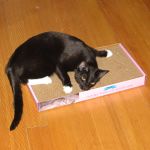



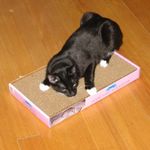
Any questions?
(This is for Michael, who has just acquired some medicinal herb to combat one of the more unpleasant side-effects of chemotherapy. I really, really hope it helps, sweetheart, and has you feeling just as frisky and playful as Sergei. If it makes you want to rub up against anyone warm and soft... well, maybe that's not the herb.)
Thursday, January 27, 2005
Let them eat cake, part I
Thirteen years ago, a friend of mine inherited a very large dining table from her mother. Although the table, made of bog oak, had no leaves, it comfortably seated 14 people. In honor of the arrival of the table in Houston from her late mother's home in California, my friend Robin and her husband Jeff held a very fancy dinner party for seven couples. For the next several years, what became known as the Bog Oak Dinner was an annual late-January tradition.
As Robin and Jeff were wine enthusiasts, they selected a different wine to go with each course of a five-course meal. As they didn't much like to cook, they assigned each couple one course of the meal to prepare. (The seventh couple didn't cook either, but they always brought marvelous bread from a nearby French bakery.) The second year of the Bog Oak Dinner, my then boyfriend and I were assigned dessert. I knew that the dessert wine would be a lovely old port; something in a dark chocolate seemed the perfect accompaniment.
I wanted to bake something - a cake or a torte perhaps - but I didn't know where to begin looking for a recipe. My college roommate Becca was known as the baker in our circle of friends, so I called her. I described the dinner, and told her that I wanted to bake the perfect, elegant dark chocolate cake to go with port.
Becca's response - in her clipped Bostonian accent - was brief: "Maida Heatter."
"What?" Those words made no sense to me.
"Get one of Maida Heatter's dessert books. My wedding cake? That was one of her recipes. She's wonderful. And you'll love reading her. Hold on a minute -" Becca's wedding cake had been both elegant and delicious; I continue to be amazed, not that she was able to create such a cake, but that she baked it for her own wedding. "- OK, this is the book you want: Maida Heatter's Book of Great Chocolate Desserts. If you don't find that one, then her Best Dessert Book Ever should have something. Pick one of the chocolate cakes that doesn't have much flour; they're all good."
I went to the bookstore the next day, bought both books, and started reading. Becca was right; these were books to be kept on one's bedside table and savored before bedtime. I read every recipe in the section of the chocolate dessert book titled "Cakes Without or Almost Without Flour," and selected three to test. This was the first of the three.
I bought baking parchment and an 8-inch springform pan. (The 6-inch and 10-inch springforms came home with me as well; never let it be said that I go into such endeavors halfheartedly!) I invited several friends over for dessert on a Sunday evening. On Saturday, my mission of acquisition yielded baking chocolate, almonds, butter, eggs, whipping cream and a nice bottle of port. After lunch on Sunday, I baked the torta. While it cooled, I napped, dreaming lovely chocolate-scented dreams.
To be continued... really...
As Robin and Jeff were wine enthusiasts, they selected a different wine to go with each course of a five-course meal. As they didn't much like to cook, they assigned each couple one course of the meal to prepare. (The seventh couple didn't cook either, but they always brought marvelous bread from a nearby French bakery.) The second year of the Bog Oak Dinner, my then boyfriend and I were assigned dessert. I knew that the dessert wine would be a lovely old port; something in a dark chocolate seemed the perfect accompaniment.
I wanted to bake something - a cake or a torte perhaps - but I didn't know where to begin looking for a recipe. My college roommate Becca was known as the baker in our circle of friends, so I called her. I described the dinner, and told her that I wanted to bake the perfect, elegant dark chocolate cake to go with port.
Becca's response - in her clipped Bostonian accent - was brief: "Maida Heatter."
"What?" Those words made no sense to me.
"Get one of Maida Heatter's dessert books. My wedding cake? That was one of her recipes. She's wonderful. And you'll love reading her. Hold on a minute -" Becca's wedding cake had been both elegant and delicious; I continue to be amazed, not that she was able to create such a cake, but that she baked it for her own wedding. "- OK, this is the book you want: Maida Heatter's Book of Great Chocolate Desserts. If you don't find that one, then her Best Dessert Book Ever should have something. Pick one of the chocolate cakes that doesn't have much flour; they're all good."
I went to the bookstore the next day, bought both books, and started reading. Becca was right; these were books to be kept on one's bedside table and savored before bedtime. I read every recipe in the section of the chocolate dessert book titled "Cakes Without or Almost Without Flour," and selected three to test. This was the first of the three.
Torta di Cioccolata
8 ounces (1 2/3 cups) blanched almonds
7 ounces (7 squares) unsweetened chocolate
1/2 pound (2 sticks) sweet butter
1 cup plus 1 tablespoon granulated sugar
4 eggs (graded large), separated
Set oven rack 1/3 up from bottom of oven; preheat to 300 degrees. Butter an 8- or 8-1/2-inch diameter, 2- or 2-1/2-inch high springform. Line the bottom with a round of baking parchment cut to fit; butter the paper.
Coarsely chop the chocolate. In a food processor or blender, grind the almonds and chocolate together to a fine powder. The danger, of course, is that you will end up with something like almond nutella. Do not overgrind.
In a large bowl of an electric mixer, cream the butter. Add the sugar, beat to mix. Add the egg yolks, beat to mix. Add the nut and chocolate mixture. Beat on low speed to mix.
In another bowl, with clean beaters, beat the egg whites until they hold firm peaks, but not until stiff or dry. Stir about 1/4 of the beaten whites into the chocolate mixture, then fold in the remaining whites. Turn into the pan; smooth the top.
Bake for 45 minutes. Allow the cake to cool to room temperature before removing the sides of the springform and inverting the cake onto a plate.
Sprinkle the top of the cake with powdered sugar, if desired. Serve with lots of cold whipped cream or vanilla ice cream.
I bought baking parchment and an 8-inch springform pan. (The 6-inch and 10-inch springforms came home with me as well; never let it be said that I go into such endeavors halfheartedly!) I invited several friends over for dessert on a Sunday evening. On Saturday, my mission of acquisition yielded baking chocolate, almonds, butter, eggs, whipping cream and a nice bottle of port. After lunch on Sunday, I baked the torta. While it cooled, I napped, dreaming lovely chocolate-scented dreams.
To be continued... really...
Wednesday, January 26, 2005
My outfits are never incomplete
 My mother was horrified when she learned that Paul and I had adopted not one, not two, but three cats after our last cat died. Perhaps horrified is a little strong; she certainly was not happy. She is allergic to cats. While her allergy is not severe, her reaction to three indoor cats is watery eyes and sneezing. When my parents come to visit, we all make adjustments. The cats are exiled from the guest room, we clean rigorously, and my mother takes antihistamines as needed.
My mother was horrified when she learned that Paul and I had adopted not one, not two, but three cats after our last cat died. Perhaps horrified is a little strong; she certainly was not happy. She is allergic to cats. While her allergy is not severe, her reaction to three indoor cats is watery eyes and sneezing. When my parents come to visit, we all make adjustments. The cats are exiled from the guest room, we clean rigorously, and my mother takes antihistamines as needed.
I've often felt that my mother does not understand how important our cats are to us, so I was quite touched when she gave me this amusing hand towel. While it may not signal an understanding of the depth of our feelings for our furry family, I feel that it shows an understanding that the cats - and the talismans of their fur that we take with us everywhere - are a fact of our lives.
Sunday, January 23, 2005
Carnival of the Cats #44: We Love Cats Here
Welcome to the 44th edition of Carnival of the Cats. Last week's Carnival certainly was fun, wasn't it? James is, umm, a tough act to follow. The Carnival will be at Watermark next week. Send your submittals to cats(at)isfullofcrap(dot)com.
Now on with the Carnival...click here.
Now on with the Carnival...click here.
Saturday, January 22, 2005
Customer Satisfaction Survey
Yesterday, I received via email the following survey from the Coffee Drink Delivery Service, which provides me with a freshly-made latte in bed each morning. My responses to the survey questions are underlined.
What, you may ask, is the Coffee Drink Delivery Service? And how might you sign up for it?
As I wrote several months ago, the CDDS is none other than my husband Paul. At that time, the delivery service had been temporarily discontinued; to my great pleasure, service has now resumed.
To sign up for this Coffee Drink Delivery Service, one must reside in the (very limited) service area. Perhaps you know someone who would be willing to start a franchise where you live.
Dear Kimberly,
We hope you have enjoyed your experience with the Coffee Drink Delivery Service. In order to monitor our performance and gauge our customer experience, we are sending you the following questions. Your answers will help us continue to improve our service. Thank you for your time.
1. My coffee drinks have usually been:
a) on-time and yummy
b) on-time, but sadly lacking in taste
c) on-time, but foul
d) late
2. My coffee drinks have been made with:
a) love
b) indifference
c) contempt and loathing
3. My coffee drinks have helped me:
a) sleep in
b) get up and go
c) in no way
4. The coffee drink delivery person is:
a) extraordinarily cute and adorable
b) sexy enough to be distracting, if I were awake
c) very kind and thoughtful
d) all of the above
5. The coffee drink song is:
a) an ever-changing source of enjoyment
b) a regular annoyance
c) something I usually sleep through
6. I wish the Coffee Drink Delivery Service would:
a) go away
b) bring me prune juice instead
c) stay the way it is
d) expand service to other cities, such as Houston when we're there
Thank you. Your responses are very important to us at the Coffee Drink Delivery Service. Again, we hope you are enjoying our service, and will continue to in the future.
Sincerely, The Coffee Drink Delivery Service
What, you may ask, is the Coffee Drink Delivery Service? And how might you sign up for it?
As I wrote several months ago, the CDDS is none other than my husband Paul. At that time, the delivery service had been temporarily discontinued; to my great pleasure, service has now resumed.
To sign up for this Coffee Drink Delivery Service, one must reside in the (very limited) service area. Perhaps you know someone who would be willing to start a franchise where you live.
A song for my cats
Recently, one of the search strings that brought someone here was "cats reactions to music." While people regularly come here while looking for music for cats, this was the first person wondering how cats - theirs, I assume - might react to music. While I can't make any sweeping generalizations about the feline population as a whole, I can say something about our cats' reactions to the music that they hear.
The cats don't pay much attention to the music CDs to which Paul and I listen, a mix of folk, jazz, and classical. They do like the cabinet that houses the stereo equipment, but that's because it is a) warm and b) cavelike. We discourage them from napping on the stereo equipment; it gets enough cat fur without their lying directly on top of it.
While our cats are curious about my violin and bow, and especially their green-velvet-lined case, they are startled by the sounds that the violin makes. If I start playing while they are in the same room, I set off a cat stampede, with all three cats heading for the opposite corner of the house. Perhaps if I played more often at home, they wouldn't be so spooked. Maybe someday I'll find out.
Our cats love when I sing to them. When we first got Sergei and Sasha, they were kittens. I wanted them to grow up accustomed to being held, so when I woke each morning, I picked each of them up and carried him around for a little while. At first, I talked to them, telling them how gorgeous they were and discussing the news on NPR. At some point, I began singing to them. I started out singing random notes and bits of nonsense doggerel, and ended up with what's known around here as the Good Morning Song. Each of the cats has his or her own verse. The boys love being held while I sing to them; I imagine that the vibrations that singing generates in my chest feel like purring to them. They purr right along with me. Lyra doesn't like to be held, but she purrs when I sing to her. (I'm usually petting her, too.) Paul noted that he was the only member of the family who didn't have a verse, so I made up one for him. When I sing it to him, he purrs, too.
 Last night, I made an audio post of Sasha's verse. As I sang into the telephone, Lyra came in and jumped up on my desk. After posting the song, I played it on my computer. Both Sasha and Sergei came into the room. Serg joined Lyra on the desk, arching his back and purring. Sasha sat on the floor, looking up at me with his head tilted to one side. He could hear his song, but I was not singing. And I was not holding him... how confusing!
Last night, I made an audio post of Sasha's verse. As I sang into the telephone, Lyra came in and jumped up on my desk. After posting the song, I played it on my computer. Both Sasha and Sergei came into the room. Serg joined Lyra on the desk, arching his back and purring. Sasha sat on the floor, looking up at me with his head tilted to one side. He could hear his song, but I was not singing. And I was not holding him... how confusing!
Click to hear Sasha's Good Morning Song. Sadly, the phone did not pick up Lyra's mewing along with me.
The cats don't pay much attention to the music CDs to which Paul and I listen, a mix of folk, jazz, and classical. They do like the cabinet that houses the stereo equipment, but that's because it is a) warm and b) cavelike. We discourage them from napping on the stereo equipment; it gets enough cat fur without their lying directly on top of it.
While our cats are curious about my violin and bow, and especially their green-velvet-lined case, they are startled by the sounds that the violin makes. If I start playing while they are in the same room, I set off a cat stampede, with all three cats heading for the opposite corner of the house. Perhaps if I played more often at home, they wouldn't be so spooked. Maybe someday I'll find out.
Our cats love when I sing to them. When we first got Sergei and Sasha, they were kittens. I wanted them to grow up accustomed to being held, so when I woke each morning, I picked each of them up and carried him around for a little while. At first, I talked to them, telling them how gorgeous they were and discussing the news on NPR. At some point, I began singing to them. I started out singing random notes and bits of nonsense doggerel, and ended up with what's known around here as the Good Morning Song. Each of the cats has his or her own verse. The boys love being held while I sing to them; I imagine that the vibrations that singing generates in my chest feel like purring to them. They purr right along with me. Lyra doesn't like to be held, but she purrs when I sing to her. (I'm usually petting her, too.) Paul noted that he was the only member of the family who didn't have a verse, so I made up one for him. When I sing it to him, he purrs, too.
 Last night, I made an audio post of Sasha's verse. As I sang into the telephone, Lyra came in and jumped up on my desk. After posting the song, I played it on my computer. Both Sasha and Sergei came into the room. Serg joined Lyra on the desk, arching his back and purring. Sasha sat on the floor, looking up at me with his head tilted to one side. He could hear his song, but I was not singing. And I was not holding him... how confusing!
Last night, I made an audio post of Sasha's verse. As I sang into the telephone, Lyra came in and jumped up on my desk. After posting the song, I played it on my computer. Both Sasha and Sergei came into the room. Serg joined Lyra on the desk, arching his back and purring. Sasha sat on the floor, looking up at me with his head tilted to one side. He could hear his song, but I was not singing. And I was not holding him... how confusing!
Click to hear Sasha's Good Morning Song. Sadly, the phone did not pick up Lyra's mewing along with me.
Friday, January 21, 2005
Feline Friday XV: Tall tails
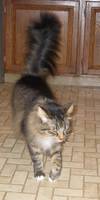
 Sasha knows that he is a beautiful boy. His tail is especially beautiful; black and shiny on the top (continuing the black stripe that runs from his head all the way down his back), and buff-colored and fluffy on the underside. Most of the time, Sasha's tail is at attention, a flag marking his movement. Sometimes I know that he is walking past our bed only because I see the end of his tail moving, like a huge dust-bunny under its own power, beyond the footboard.
Sasha knows that he is a beautiful boy. His tail is especially beautiful; black and shiny on the top (continuing the black stripe that runs from his head all the way down his back), and buff-colored and fluffy on the underside. Most of the time, Sasha's tail is at attention, a flag marking his movement. Sometimes I know that he is walking past our bed only because I see the end of his tail moving, like a huge dust-bunny under its own power, beyond the footboard.
Wednesday, January 19, 2005
Leaping
A couple of weeks ago, I started the second quarter of the memoir writing classes that I'm taking at the UW Extension Writers Program. At the beginning of last quarter, I wrote about the class once or twice. Since I expect to be working harder at producing material for the class this quarter, I'll probably post some of the quick drafts and sketch exercises, as I did here and here last quarter. This is one such fairly short writing exercise. My classmates will give me feedback on this next week (as I will on their writing). It's a process that I sometimes find painful, and always find valuable, so feel free to leave your thoughts.
----------
In February of 1996, I moved to the California Bay Area to live with Paul. He flew to Houston so that we could make the drive west together. When we finished packing my little teal Prizm, the trunk would just barely close, and the back seat was filled to the level of the windows. Along with clothes and other practical necessities were items too precious to leave to the not-so-tender mercies of a moving company: my camera, some artwork, and my violin. I had wanted to take my black cat, Samantha, but I knew from past experience that she would be miserable - and would make us miserable - on the drive. My parents would put her on a flight to California after Paul and I arrived there.
On the morning of the 25th, we happily set off on our second cross-country adventure. Tucked into the crook of my arm as I backed out of my parents' driveway was a small black shearling teddy bear. I'd bought him the day before, responding to a sudden urge to have something soft and furry to hold while making the trip. His name, from the moment I saw him, was Leap Bear, in part for the leap year, but even more for the momentous move that I was making to be with Paul.
After five days of barreling across the country, watching the scenery change while we talked and listened to music and talked some more, and four nights of sleeping entwined in roadside motels, we arrived in the late afternoon of March 1 at a small apartment complex in Mountain View. The building looked a bit like one of the motels in which we had recently stayed. We walked up a narrow outside stair to the apartment door.
Paul unlocked the door to the apartment that was to be our first home together. I walked in, and stopped just inside the door. Paul followed me, closing the door behind himself. My eyes made a quick assessment: gray carpeted living room, white walls, small kitchen to one side, small hall to the other, not much furniture. The room looked bleak, and suddenly I felt bleak, and lonely, and scared.
"I want to go home," I wailed, and burst into tears.
Paul pulled me close. Resting his bearded cheek against the top of my head, he stroked my back. "Oh, honey, it's OK. I know youre scared, and you're tired. You've just done a really big thing, moving out here with me."
I was crying so hard that I couldn't speak. I just nodded my head against his chest, and held on to his shirt.
When my crying slowed, Paul took my chin in his hand, and turned my face up toward his. His deep blue eyes were sad and serious. "I love you, and I really want you to be happy here. If you're not, you can go back to Houston." Running his thumb across my cheek, he brushed away a few stray tears. "But would you give it a week, at least? Or two?" I hiccupped, and one corner of his mouth quirked up.
"I didnt mean that I wanted to go home tonight," I managed to say before the next hiccup came. When it did, we both grinned.
After a crying jag, I get the hiccups. From past experience with my tears, Paul knows this pattern. Sometimes there are only one or two; other times they persist. Paul smoothed my hair back from my face, pulling it into a dark ponytail; we waited. When I hiccupped again, he kissed me quickly, and let my hair fall onto my back. Walking toward the small kitchen, he asked, "Cold or lukewarm?"
"Lukewarm's hicc fine." I followed him into the kitchen, where he was pouring a glass of water at the sink. When he turned to hand it to me, I saw that the front of his shirt was damp. Taking the glass with one hand, I drank. With the other, I traced the pattern of tearstains on his chest.
"Yeah, look at that," he smiled, looking down at the his shirt.
"I've gone and gotten your shirt all wet. It's been a long time since that happened." I put the glass on the counter. My hiccups were gone. My other hand joined the first, resting lightly on the damp fabric.
"You had lots of good reasons for crying when we were together before," he said quietly. "We both did."
"Let's plan on not doing so much of that ever again." I traced a small scar on his collarbone, one of several from that time. "I think we've had enough for one lifetime."
"How right you are." We stood for a moment, remembering. Paul leaned down to kiss my forehead. "So, how 'bout we get a few things out of your car, and then I take you out for dinner?"
We brought in my violin, and Leap Bear, and our suitcases. That was enough. I had added something of mine to the apartment. We were ready for dinner.
Paul drove us in his car to a Chinese restaurant near the apartment. The interior of the restaurant was beautiful: simple black and white décor with lacquer red Asian artwork. When I commented on how pretty it was, Paul smiled. The man knows what I like. At six o'clock on a Friday evening, we had the room to ourselves. For a few minutes, we sipped tea, not talking, listening to the quiet music of an Asian stringed instrument. We ordered my favorites: orange peel beef, twice cooked green beans and though Paul does not care for it eggplant in garlic sauce. The food was wonderful; we ate slowly, almost meditatively. By the end of our meal, I was sated, calm, and sleepy.
On the drive back to the apartment, I thanked Paul. "That dinner was perfect, sweetheart. The place was lovely, the food was lovely... it was just what I needed."
He smiled, and reached over to take my hand. "I thought you would like it. I wanted to go someplace away from your car, away from the apartment, where we could just stop moving for a while and be together."
We turned onto his street... our street. This time, I recognized the turn. At the top of the stairs, he paused, and reached into his pocket. "I have something for you." He handed me a pair of keys on a small ring. "The small one's for our storage locker downstairs. The big ones for our door. I tested them when I had them made, and they both work."
Putting my key in the lock, I opened the door to our apartment. This time, the room looked not bleak, but unsettled, and a little bare. It needed some color, some artwork, and a small black cat waiting for us to come home. And that would come; it would just take a little time.
Later that night, I was almost asleep, my head resting on Pauls shoulder. I thought that he was asleep until he sighed and pulled me closer to him. "Oh, Kimmy, I was really stunned when you said you wanted to go home. I didn't know what to do."
"You did all the right things, Paul. Everything you said and did; it was just right." I reached behind me, and found Leap Bear at the edge of the bed. Placing him on Paul's chest, I said, "Here's Leap Bear. You can hold onto him, too. We can both hold onto him together."
----------
In February of 1996, I moved to the California Bay Area to live with Paul. He flew to Houston so that we could make the drive west together. When we finished packing my little teal Prizm, the trunk would just barely close, and the back seat was filled to the level of the windows. Along with clothes and other practical necessities were items too precious to leave to the not-so-tender mercies of a moving company: my camera, some artwork, and my violin. I had wanted to take my black cat, Samantha, but I knew from past experience that she would be miserable - and would make us miserable - on the drive. My parents would put her on a flight to California after Paul and I arrived there.
On the morning of the 25th, we happily set off on our second cross-country adventure. Tucked into the crook of my arm as I backed out of my parents' driveway was a small black shearling teddy bear. I'd bought him the day before, responding to a sudden urge to have something soft and furry to hold while making the trip. His name, from the moment I saw him, was Leap Bear, in part for the leap year, but even more for the momentous move that I was making to be with Paul.
After five days of barreling across the country, watching the scenery change while we talked and listened to music and talked some more, and four nights of sleeping entwined in roadside motels, we arrived in the late afternoon of March 1 at a small apartment complex in Mountain View. The building looked a bit like one of the motels in which we had recently stayed. We walked up a narrow outside stair to the apartment door.
Paul unlocked the door to the apartment that was to be our first home together. I walked in, and stopped just inside the door. Paul followed me, closing the door behind himself. My eyes made a quick assessment: gray carpeted living room, white walls, small kitchen to one side, small hall to the other, not much furniture. The room looked bleak, and suddenly I felt bleak, and lonely, and scared.
"I want to go home," I wailed, and burst into tears.
Paul pulled me close. Resting his bearded cheek against the top of my head, he stroked my back. "Oh, honey, it's OK. I know youre scared, and you're tired. You've just done a really big thing, moving out here with me."
I was crying so hard that I couldn't speak. I just nodded my head against his chest, and held on to his shirt.
When my crying slowed, Paul took my chin in his hand, and turned my face up toward his. His deep blue eyes were sad and serious. "I love you, and I really want you to be happy here. If you're not, you can go back to Houston." Running his thumb across my cheek, he brushed away a few stray tears. "But would you give it a week, at least? Or two?" I hiccupped, and one corner of his mouth quirked up.
"I didnt mean that I wanted to go home tonight," I managed to say before the next hiccup came. When it did, we both grinned.
After a crying jag, I get the hiccups. From past experience with my tears, Paul knows this pattern. Sometimes there are only one or two; other times they persist. Paul smoothed my hair back from my face, pulling it into a dark ponytail; we waited. When I hiccupped again, he kissed me quickly, and let my hair fall onto my back. Walking toward the small kitchen, he asked, "Cold or lukewarm?"
"Lukewarm's hicc fine." I followed him into the kitchen, where he was pouring a glass of water at the sink. When he turned to hand it to me, I saw that the front of his shirt was damp. Taking the glass with one hand, I drank. With the other, I traced the pattern of tearstains on his chest.
"Yeah, look at that," he smiled, looking down at the his shirt.
"I've gone and gotten your shirt all wet. It's been a long time since that happened." I put the glass on the counter. My hiccups were gone. My other hand joined the first, resting lightly on the damp fabric.
"You had lots of good reasons for crying when we were together before," he said quietly. "We both did."
"Let's plan on not doing so much of that ever again." I traced a small scar on his collarbone, one of several from that time. "I think we've had enough for one lifetime."
"How right you are." We stood for a moment, remembering. Paul leaned down to kiss my forehead. "So, how 'bout we get a few things out of your car, and then I take you out for dinner?"
We brought in my violin, and Leap Bear, and our suitcases. That was enough. I had added something of mine to the apartment. We were ready for dinner.
Paul drove us in his car to a Chinese restaurant near the apartment. The interior of the restaurant was beautiful: simple black and white décor with lacquer red Asian artwork. When I commented on how pretty it was, Paul smiled. The man knows what I like. At six o'clock on a Friday evening, we had the room to ourselves. For a few minutes, we sipped tea, not talking, listening to the quiet music of an Asian stringed instrument. We ordered my favorites: orange peel beef, twice cooked green beans and though Paul does not care for it eggplant in garlic sauce. The food was wonderful; we ate slowly, almost meditatively. By the end of our meal, I was sated, calm, and sleepy.
On the drive back to the apartment, I thanked Paul. "That dinner was perfect, sweetheart. The place was lovely, the food was lovely... it was just what I needed."
He smiled, and reached over to take my hand. "I thought you would like it. I wanted to go someplace away from your car, away from the apartment, where we could just stop moving for a while and be together."
We turned onto his street... our street. This time, I recognized the turn. At the top of the stairs, he paused, and reached into his pocket. "I have something for you." He handed me a pair of keys on a small ring. "The small one's for our storage locker downstairs. The big ones for our door. I tested them when I had them made, and they both work."
Putting my key in the lock, I opened the door to our apartment. This time, the room looked not bleak, but unsettled, and a little bare. It needed some color, some artwork, and a small black cat waiting for us to come home. And that would come; it would just take a little time.
Later that night, I was almost asleep, my head resting on Pauls shoulder. I thought that he was asleep until he sighed and pulled me closer to him. "Oh, Kimmy, I was really stunned when you said you wanted to go home. I didn't know what to do."
"You did all the right things, Paul. Everything you said and did; it was just right." I reached behind me, and found Leap Bear at the edge of the bed. Placing him on Paul's chest, I said, "Here's Leap Bear. You can hold onto him, too. We can both hold onto him together."
Monday, January 17, 2005
Beyond Vietnam: A Time to Break Silence
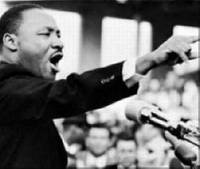 On April 4, 1967, the Rev. Martin Luther King Jr. addressed a meeting of the Clergy and Laity Concerned at the Riverside Church in New York City. This was one of the first times that King had spoken out against the war in Vietnam. He was no longer speaking only to issues of race, but to those of class and foreign policy.
On April 4, 1967, the Rev. Martin Luther King Jr. addressed a meeting of the Clergy and Laity Concerned at the Riverside Church in New York City. This was one of the first times that King had spoken out against the war in Vietnam. He was no longer speaking only to issues of race, but to those of class and foreign policy.
In this excerpt from the speech, King discussed the shift in values that he believed was required of our country (emphasis mine):
<...> the words of the late John F. Kennedy come back to haunt us. Five years ago he said, "Those who make peaceful revolution impossible will make violent revolution inevitable." Increasingly, by choice or by accident, this is the role our nation has taken, the role of those who make peaceful revolution impossible by refusing to give up the privileges and the pleasures that come from the immense profits of overseas investments. I am convinced that if we are to get on the right side of the world revolution, we as a nation must undergo a radical revolution of values. We must rapidly begin the shift from a thing-oriented society to a person-oriented society. When machines and computers, profit motives and property rights, are considered more important than people, the giant triplets of racism, extreme materialism, and militarism are incapable of being conquered.
A true revolution of values will soon cause us to question the fairness and justice of many of our past and present policies. On the one hand we are called to play the Good Samaritan on life's roadside, but that will be only an initial act. One day we must come to see that the whole Jericho Road must be transformed so that men and women will not be constantly beaten and robbed as they make their journey on life's highway. True compassion is more than flinging a coin to a beggar. It comes to see that an edifice which produces beggars needs restructuring.
A true revolution of values will soon look uneasily on the glaring contrast of poverty and wealth. With righteous indignation, it will look across the seas and see individual capitalists of the West investing huge sums of money in Asia, Africa, and South America, only to take the profits out with no concern for the social betterment of the countries, and say, "This is not just." It will look at our alliance with the landed gentry of South America and say, "This is not just." The Western arrogance of feeling that it has everything to teach others and nothing to learn from them is not just.
A true revolution of values will lay hand on the world order and say of war, "This way of settling differences is not just." This business of burning human beings with napalm, of filling our nation's homes with orphans and widows, of injecting poisonous drugs of hate into the veins of peoples normally humane, of sending men home from dark and bloody battlefields physically handicapped and psychologically deranged, cannot be reconciled with wisdom, justice, and love. A nation that continues year after year to spend more money on military defense than on programs of social uplift is approaching spiritual death.
America, the richest and most powerful nation in the world, can well lead the way in this revolution of values. There is nothing except a tragic death wish to prevent us from reordering our priorities so that the pursuit of peace will take precedence over the pursuit of war. There is nothing to keep us from molding a recalcitrant status quo with bruised hands until we have fashioned it into a brotherhood.
This kind of positive revolution of values is our best defense against communism. War is not the answer. Communism will never be defeated by the use of atomic bombs or nuclear weapons. Let us not join those who shout war and, through their misguided passions, urge the United States to relinquish its participation in the United Nations. These are days which demand wise restraint and calm reasonableness. We must not engage in a negative anticommunism, but rather in a positive thrust for democracy, realizing that our greatest defense against communism is to take offensive action in behalf of justice. We must with positive action seek to remove those conditions of poverty, insecurity, and injustice, which are the fertile soil in which the seed of communism grows and develops.
One year - to the day - after giving this address in New York City, Martin Luther King Jr. was assassinated in Memphis.
This speech is much less well known than King's "I Have a Dream" speech. While long, it is well worth a complete read; the "war on terror" has made it quite topical again. As you read it, consider making the following substitutions: for Vietnam, Iraq; for communism or Marxism, terror. While King's assassination deprived us and the rest of the world of the chance to see and hear what he would have said regarding the issues of our day, I think that his words with regard to the current war would not have been much different than these.
Read full text of speech here.


 Music and Cats
Music and Cats